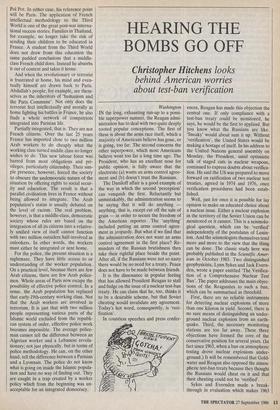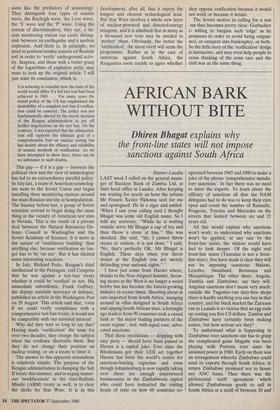HEARING THE BOMBS GO OFF
Christopher Hitchens looks
behind American worries about test-ban verification
Washington IN the long, exhausting run-up to a possi- ble superpower summit, the Reagan admi- nistration has to deal with two quite deeply rooted popular conceptions. The first of these is about the arms race itself, which a majority of Americans believe has gone, or is going, too far. The second concerns the other superpower, which most Americans believe went too far a long time ago. The President, who has an excellent nose for public opinion, is fully aware that the electorate (a) wants an arms control agree- ment and (b) doesn't trust the Russians.
The Daniloff affair is a good example of the way in which the second `perception' can vanquish the first. Reluctantly but unmistakably, the administration seems to be saying that it will do anything anything, that is, except cut off the sale of grain — in order to secure the freedom of the American reporter. The 'anything' included putting an arms control agree- ment in jeopardy. But what if we find that the administration does not want an arms control agreement in the first place? Re- minders of the Russian brutishness then take their rightful place beside the point. After all, if the Russians were not so nasty there would be no need for a treaty. Peace does not have to be made between friends.
It is the dissonance in popular feeling that has allowed President Reagan to stall and fudge on the issue of a nuclear test-ban treaty. He can claim that he, too, thinks it to be a desirable scheme, but that Soviet cheating would invalidate any agreement. Today's hot word, consequently, is 'veri- fication'.
In countless speeches and press confer- ences, Reagan has made this objection the central one. If only compliance with a test-ban treaty could be monitored, he says, he would be the first to applaud. But you know what the Russians are like. `Sneaky' would about sum it up. Without `verification', the United States would be making a hostage of itself. In his address to the United Nations general assembly on Monday, the President, amid optimistic talk of staged cuts in nuclear weapons, continued to express doubts about verifica- tion. He said the US was prepared to move forward on ratification of two nuclear test treaties, agreed in 1974 and 1976, once verification procedures had been estab- lished.
Well, just for once it is possible for Iay opinion to make an educated choice about a nuclear issue. Ether a nuclear explosion in the territory of the Soviet Union can be monitored or it cannot. This is a seismolo- gical question, which can be 'verified' independently of the postulates of Lenin- ism. And the seismologists themselves tend more and more to the view that the thing can be done. The classic study here was probably published in the Scientific Amer- ican in October 1983. Two distinguished geophysicists, Lynn Sykes and Jack Evern- den, wrote a paper entitled 'The Verifica- tion of a Comprehensive Nuclear Test Ban'. The paper addresses the main objec- tions of the Reaganites to such a ban, which can be summarised as threefold.
First, there are no reliable instruments for detecting nuclear explosions of more than one kiloton in yield. Second, there is no sure means of distinguishing an under- ground nuclear explosion from an earth- quake. Third, the necessary monitoring stations are too far away. These three objections have formed the core of the conservative position for several years. (In fact since 1963, when a ban on atmospheric testing drove nuclear explosions under- ground.) It will be remembered that Gold- water and Reagan also opposed the atmos- pheric test-ban treaty because they thought the Russians would cheat on it and that their cheating could not be 'verified'.
Sykes and Evernden made a break- through in evaluation which makes 1963 seem like the prehistory of seismology. They distinguish four types of seismic wave, the Rayleigh wave, the Love wave, the 'S' wave and the `P' wave. Using the system of discrimination, they say, a de- cent monitoring station can easily disting- uish between an earthquake and a nuclear explosion. And there is, in principle, no need to position seismic sensors on Russian soil in order to 'verify' underground activ- ity. Sceptics, and those with a better grasp of the logarithms of explosive yield, may want to look up the original article. I will just state its conclusion, which is: It is sobering to consider how the state of the world would differ if a full test ban had been achieved in 1963 . . . For many years the stated policy of the US has emphasised the desirability of a complete test ban if verifica- tion could be ensured. The policy was not fundamentally altered by the recent decision of the Reagan administration to put off further negotiations on the test ban. On the contrary, it was reported that the administra- tion still supports the ultimate goal of a comprehensive ban on nuclear testing but has doubts about the efficacy and reliability of seismic methods of verification. As we have attempted to show here, there can be no substance to such doubts.
This gap — if it is a gap — between the political view and the view of seismologists has led to an extraordinary parallel policy. In July last, a team of American seismolog- ists went to the Soviet Union and began installing three monitoring stations around the main Russian test site at Semipalatinsk. The Sunday before last, a group of Soviet scientists arrived to begin doing the same thing in the vicinity of American test sites in Nevada. This is the result of a private deal between the Natural Resources De- fence Council in Washingtbn and the Soviet Academy of Sciences. It is more in the nature of 'confidence building' than anything else, because verification no lon- ger has to be 'on site'. But it has elicited some interesting reactions.
In July, Richard Perle, Reagan's chief intellectual at the Pentagon, told Congress that he was against a test-ban treaty whether it could be 'verified' or not. His immediate subordinate, Frank Gaffney, the deputy assistant secretary of defence, published an article in the Washington Post on 29 August. This article said that, 'even if we could verify compliance with a comprehensive test ban treaty, it would not be compatible with our national interest'.
Why did they wait so long to say this? Having made 'verification' the issue for over two decades, they change the subject when the evidence discredits them. But they do not change their position on nuclear testing, or on a treaty to limit it.
The answer to this apparent conundrum is relatively simple. The purpose of the Reagan administration in dumping the Salt II treaty this summer, and in urging numer- ous 'modifications' to the Anti-Ballistic Missile (ABM) treaty as well, is to clear the decks for Star Wars. It is in this development, after all, that it enjoys the longest and clearest technological lead. But Star Wars involves a whole new layer of nuclear-powered and directed-energy weapons, and it is admitted that as many as a thousand new tests may be needed to `perfect' them. Obviously, the better the `verification', the more overt will seem the programme. Rather as in the case of sanctions against South Africa, the Reaganites seem unable to agree whether they oppose verification because it would not work or because it would.
The Soviet motive in calling for a test oan thus becomes pretty clear. Gorbachev i ; willing to bargain such 'edge' as he possesses in order to avoid being outgun- ned, or outspent into bankruptcy, or both. So the little story of the 'verification' dodge is instructive, and may even help people to cease thinking of the arms race and the cold war as the same thing.



























































 Previous page
Previous page